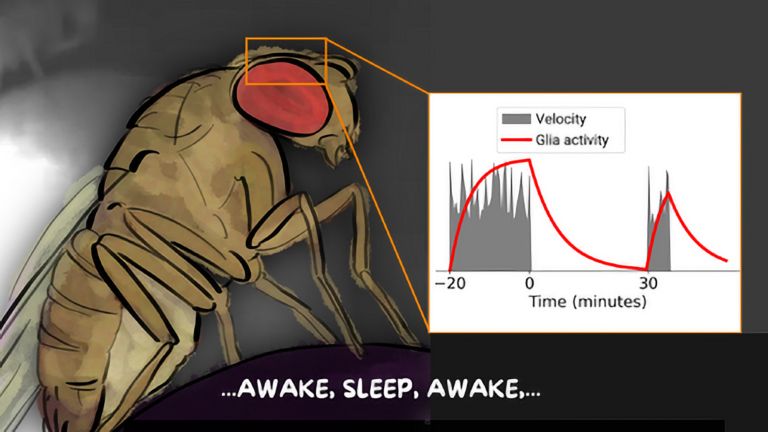What makes a fly feel sleepy – and how does the brain know when it's time to rest?

Sleep is essential across species, from flies to humans. While its function is not yet fully understood, sleep plays a crucial role in restoring energy, clearing waste, and regulating brain metabolism to maintain optimal brain function. But how does the brain know when it’s time to rest?
Published: 21.04.2025
A new study from our Neural Circuits research group explores this question by showing that non-neuronal cells in the brain – glial cells – play an active role in regulating sleep and rest, and how this is related to metabolism in fruit flies Drosophila melanogaster. Once seen as mere support cells in the nervous system, glial cells are today recognized as key regulators of sleep. Our team advances this understanding by demonstrating how glial cells in different brain regions track the duration of wakefulness and periods of rest and sleep in flies, and how this is linked to the metabolic demands of neural activity. The study shows that glia function as a brain-wide system for managing local sleep homeostasis in different brain regions. Additionally, a previously identified sleep-promoting population of neurons also contributes to feeding homeostasis, potentially linking sleep and feeding behavior to coordinate both sleep and energy balance
Using advanced long-term imaging over several days, our researchers tracked glial activity while simultaneously monitoring the behavior of the fly. Glial activity exhibited clear circadian oscillations across the 24-hour cycle and closely mirrored the behavioral state—rising during wakefulness, particularly when flies walk or engage in effortful tasks, and gradually decreasing during rest and sleep. Therefore, glial activity serves as an internal sensor of sleep need: when glial activity is low, flies are fully rested, whereas sleep deprivation leads to elevated glial activity. Furthermore, optogenetic activation of glial cells – using light to precisely control cell activity – promote rest, suggesting that glial activity not only reflects the fly’s level of sleepiness but also plays an active role in regulating rest behavior.
Our study also showed that changes in glial activity are driven by the accumulation of metabolic byproducts, primarily CO₂ and associated pH changes. During wakefulness, high neural activity raises CO₂ levels, lowering brain pH and creating acidity that can disrupt neuronal function. We found that glia in flies possess the machinery to regulate pH and remove CO₂ via tracheal tubes in the brain. Glial activity rises with elevated CO₂ and acidity, suggesting a role in clearing metabolic waste and maintaining physiological balance. As neural activity drops during sleep, CO₂ production declines, and glial activity correspondingly decreases. These findings support a model in which glia respond to neuronal metabolic demand during wakefulness and promote sleep when conditions become unsustainable.
Published in Nature Neuroscience, our study highlights the critical role of glial cells in orchestrating fundamental biological processes such as sleep. First author Andres Flores-Valle explains, “By uncovering the mechanisms that drive sleep in fruit flies, we can gain valuable insights into the fundamental functions of sleep in more complex organisms, including humans”.
Original publication
Andres Flores-Valle, Ivan Vishniakou, Johannes D. Seelig; Dynamics of glia and neurons regulate homeostatic rest, sleep and feeding behavior in Drosophila; Nature Neuroscience 2025
https://www.nature.com/articles/s41593-025-01942-1